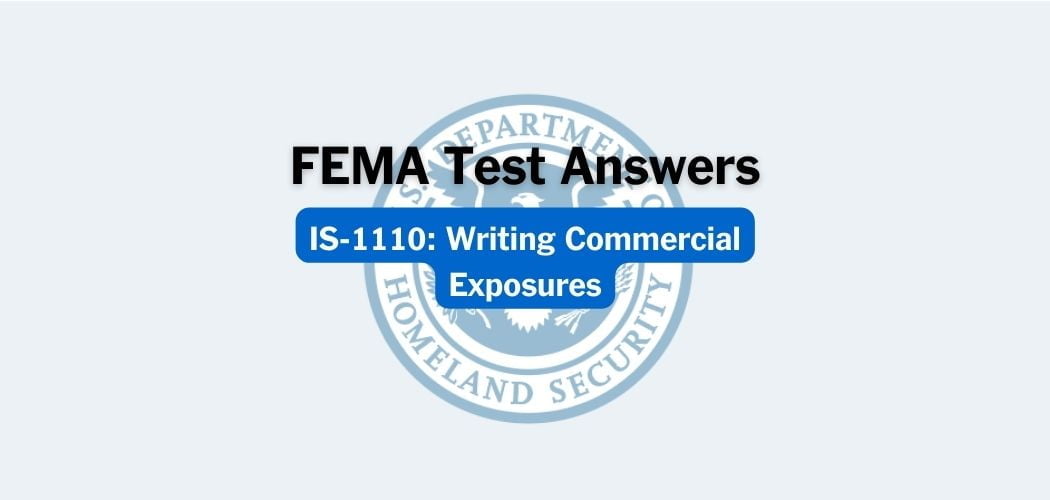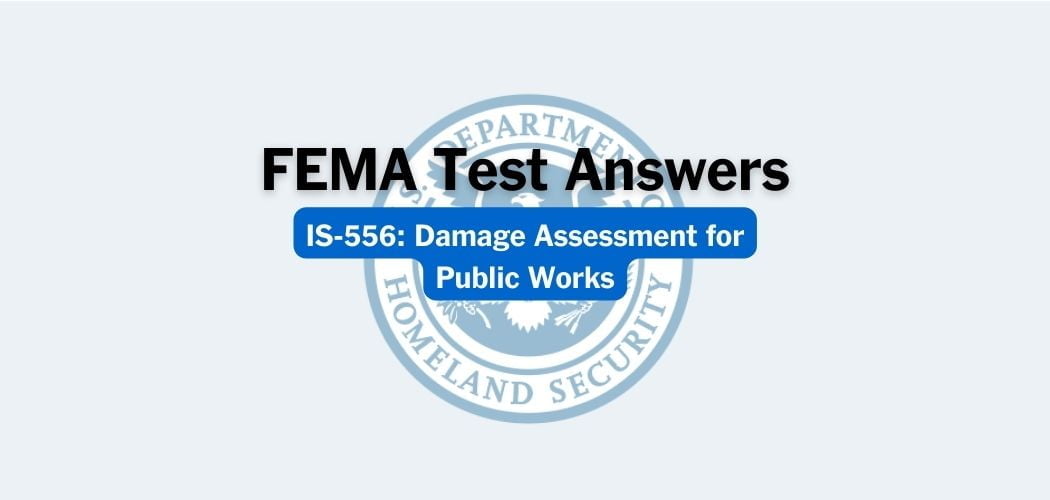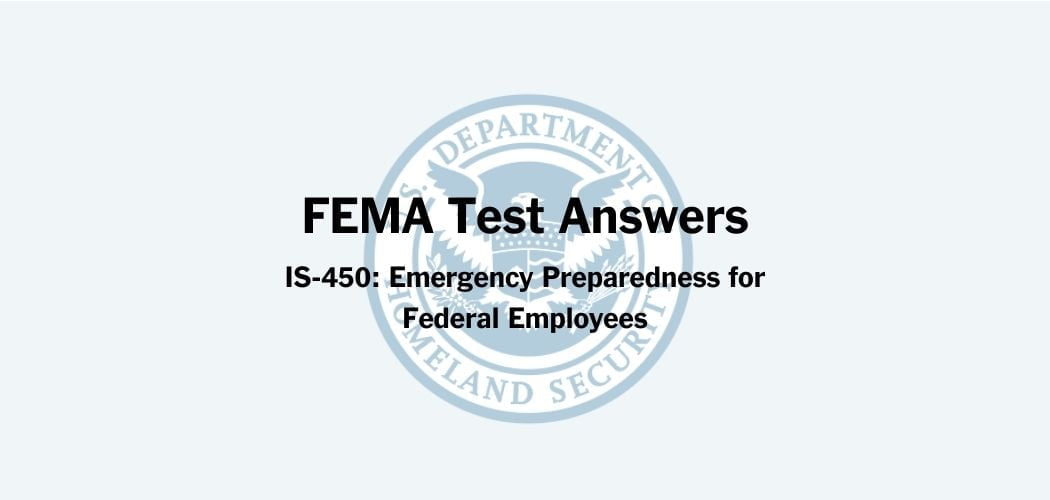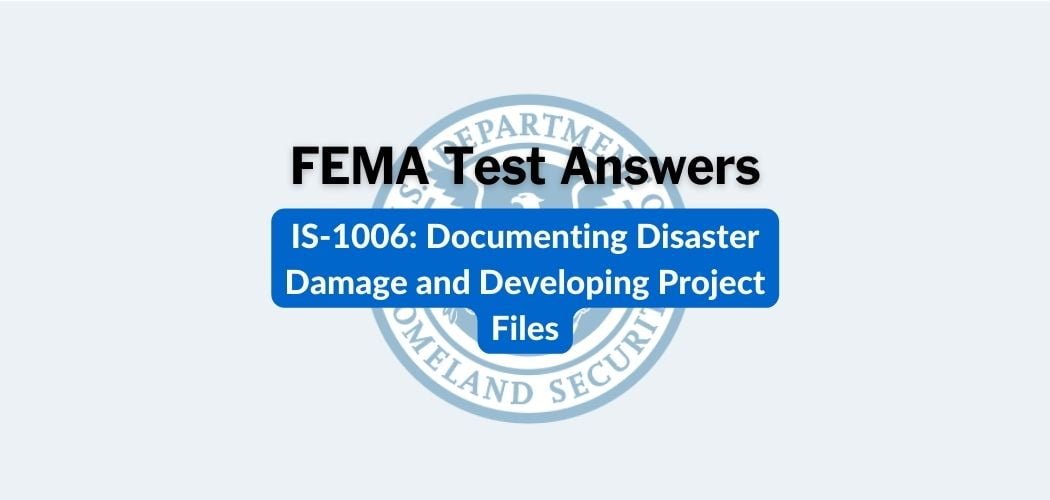Overview: The FEMA IS-1017 course was published on 2/28/2019 to provide an overview of Public Assistance project eligibility.
By the end of the course, State, Local, Indian Tribal, and Territorial Applicants and Recipients will be able to describe all aspects of scope change requests, time extensions, and Improved and Alternate Project requests.
FEMA IS-1017 test answers
Each time this test is loaded, you will receive a unique set of questions and answers. The test questions are scrambled to protect the integrity of the exam.
Question 1. If all projects are completed early, the Recipient should request ________ before the Period of Performance is over.
A. An audit
B. Grant closeout✅
C. Additional funding
D. A time extension
Question 2. If a Recipient or Applicant fails to comply with any term of the Public Assistance award, FEMA may:
A. Suspend or terminate the current award for the Recipient or Applicant’s program✅
B. Determine that the Applicant and Recipient should begin the appeals process
C. Require that the Applicant and Recipient apply for capped project funding
D. Ask the Applicant and recipient to start the Public Assistance process over again
Question 3. During the performance of eligible work, project completion deadlines are set from the date that a major disaster or emergency is declared and apply to what type of projects?
A. All projects approved under State disaster assistance grants✅
B. Onsite and offsite projects
C. Period of Performance projects
D. Damage Inventory Projects
Question 4. If an Applicant determines the need for additional time to complete a project, including direct administrative tasks related to the project, the Applicant must submit a written request for what?
A. A Net Project appeal
B. An Alternate Project
C. A time extension✅
D. An Improved Project
Question 5. The period of time during which the Recipient is expected to complete all physical work and incur and expend approved funds is called the:
A. Period of Work
B. Approved Work Timeline
C. Period of Performance✅
D. Disaster Work Period
Question 6. All of the following are generally eligible reasons for a change in scope of work EXCEPT:
A. The alternate repair method is less cost-effective than the original repair method.✅
B. Hidden, disaster-related damage is discovered during construction.
C. The original repair method is not technically feasible.
D. There is an increase in previously approved quantities due to errors and omissions.
Question 7. What type of project allows an Applicant to use Public Assistance funds differently than for restoring a facility to pre-disaster design and function, with funding based on the estimated amount needed to restore the facility to pre-disaster design and function?
A. Improved Repair Methods
B. Capped Projects✅
C. Construction Improvements
D. Net Small Projects
Question 8. What is the purpose of providing a request for a change in the scope of work?
A. To determine if the new scope of work should be entered into Grants Portal
B. To find out if the Recipient will help pay for the changes in work
C. To determine if the Applicant’s changes were beyond the Applicant’s control
D. To allow FEMA time to review and determine the eligibility of the changes in work✅
Question 9. If an Improved Project significantly changes the pre-disaster configuration of a facility, the Recipient must forward the Applicant’s request to FEMA to ensure that the Improved Project complies with:
A. Alternative Project laws
B. Improved Project laws
C. Environmental and Historic Preservation laws✅
D. Hazard mitigation laws
Question 10. When requesting changes in the scope of work, Applicants must ensure that the work is performed within the FEMA Public Assistance specified __________.
A. History of Performance
B. Length of Performance
C. Period of Performance✅
D. Time of Performance
Question 11. If an Alternate Project involves construction, the Applicant must obtain FEMA approval prior to what?
A. Starting construction on the project✅
B. Applying for an Improved Project
C. Changing Hazard Mitigation procedures
D. Starting a second Environmental Assessment
Question 12. To determine eligibility for Permanent Relocation projects, FEMA looks at whether the project is:
A. Beneficial to the Recipient
B. A small project
C. Cost-effective✅
D. A capped project
Question 13. If a change in the scope of work will affect the ability to complete the project within the Period of Performance, the Applicant must request a written ________.
A. project re-evaluation
B. scope change request✅
C. delayed project request
D. time extension
Question 14. When requesting a change in scope of work, if additional damage to the facility is involved, the Applicant may need to show:
A. How the damage is disaster-related
B. A record of the Site Inspection
C. Why the damage needs to be fixed
D. A record of the Damage Inventory✅
Question 15. A change in the scope of work request must clearly explain the reason for the scope change, including:
A. The full Administrative Record✅
B. Alternate project requests
C. Construction timeline and project schedule
D. A Benefits-Cost Analysis
Question 16. Not having proper documentation throughout the closeout of a project may generate what?
A. A facilitated discussion
B. A site inspection
C. An audit
D. An appeal✅
Question 17. Who is responsible for documenting every step of a Public Assistance-funded project and keeping FEMA informed of any action that might differ from the approved Statement of Work?
A. The Environmental and Historic Preservation Specialist
B. The Applicant✅
C. The Hazard Mitigation Specialist
D. The Site Inspector
Question 18. If an Applicant does not properly request scope changes or commences with work before the scope change request is approved, the Applicant may face audits, delays in funding, or:
A. A second site inspection
B. A second Environmental Assessment
C. An Improved Project Plan
D. Loss of funding✅
Question 19. FEMA will screen requested changes in a scope of work for potential ______ impact and ensure they are eligible for Public Assistance Program funding.
A. measurable✅
B. contractual
C. environmental
D. structural
Question 20. The Recipient has the authority to extend deadlines for 30 months for individual projects based on extenuating circumstances for what type of work?
A. Alternative Work
B. Improved Work
C. Emergency Work
D. Permanent Work✅



